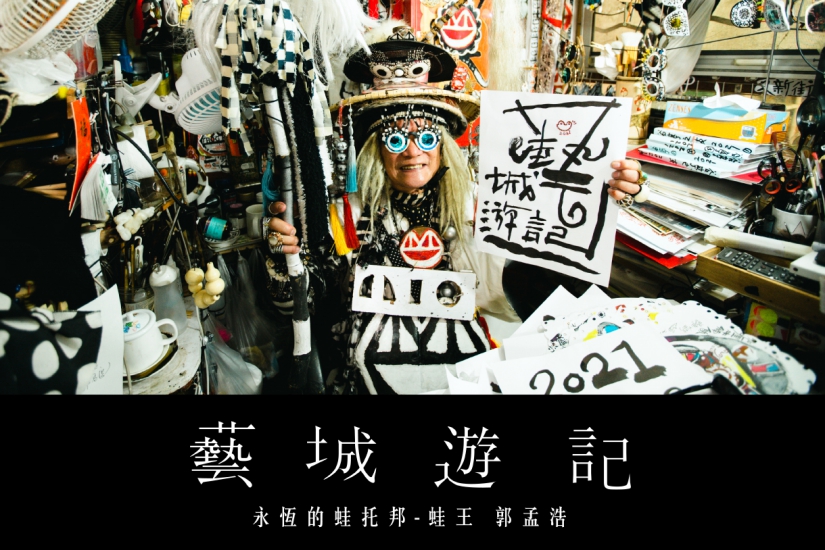Whenever the name “Frog King” Kwok Mang-ho is mentioned, others always refer to him as: the first person in performance art, the mischievous old man of the art world, the pioneer of conceptual art, or even a madman. Many people think that he made a name for himself in the art world with his eccentric outfits, but as early as the 1970s, in a conservative social atmosphere, he was already creating various unconventional experimental art pieces. Despite the constant misunderstanding and disdain from others, Frog King persisted in taking the unconventional path, using his body as a medium of communication, and using different types of materials to create various experiments, sculptures, paintings, installations, and more. After half a century, his position in the art world is now unshakable. Although he is 74 years old, he still actively participates in the local art scene with great energy. Whenever Frog King participates in a large art exhibition, he still wanders around in his “frog outfit,” enjoying himself and never getting tired. Engaging in such a mentally consuming activity for decades, what exactly is he still persisting in?
The Frog King now hides deep in the rural outskirts of Yuen Long, but he is not disconnected from the outside world because of this. He continues to create, using art to connect with the community, even decorating his own home like a small museum with various installations. From the village paths extending to a wing of his home, every corner is occupied by “frog” motifs, creating a unique artistic territory. This episode of “Art City Travelogue” leaves the city and follows the Frog King deep into the Frog Jungle he has built single-handedly, hoping to catch a glimpse of the ideal kingdom he has spent his whole life creating.
On the day of the visit, Frog King appeared in a full set of “frog outfit”. In the scorching August summer, he wore thick knitted sleeves, a wig and hat on his head, different accessories on his neck and hands, frog eyes glasses, holding a cane, slowly walking into our sight. Throughout the day, he led us to visit his “Frog Museum”, then went to his new home and studio in Ngau Tam Mei for a visit, and even improvised a large-scale experimental art performance for us. Despite sweating profusely, he never complained of tiredness. He said he had been used to it for so many years, his eyes and tone of voice never lie, and the transformed Frog King actually enjoys it. For the performance prepared for our visit, he happily said, “I can have fun again!”
“I am more than just performance art”
Guo Menghao, who is naturally active and full of “mischievous ideas”, has never lived by the rules since he was young. While others dislike the noisy frog, in his eyes, it is fearless of criticism and enjoys itself, much like his own projection. As he grew up, while others would only choose one girl to dance with at a party, he invited the entire class of girls to attend, everyone had a great time, and he called himself the “Frog Prince”. Later, when he moved to New York, the former prince naturally upgraded to a king, and he began to identify himself as the Frog King, leaving his mark in the art world. The Frog King we see today has actually evolved over several decades. Back in the late 1970s, during the early days of China’s reform and opening up, he was already performing plastic bag installation art at Tiananmen Square in Beijing. At that time, the identity of the Frog King had not yet taken shape, but that performance was already recognized as the first recorded performance art event in China.
However, for this groundbreaking achievement, the Frog King is not impressed. He believes that his actions are simply categorized by objective conditions and do not hold much significance. For him, performance art is a behavior supported by intention, combined with numerous practical experiences, naturally becoming performance art. In simple terms, a conscious and conceptual life is already a work of art. He said, “I did a lot of performance art in the 70s, so others said it was performance art, but later I did a lot of sculpture, installations, experiments, which others did not mention. After 2000, my creations were still classified as performance art, but I don’t like this term.” Being called the “Hong Kong original performance artist” may sound like a lofty honor to others, but to the Frog King, it feels like being trapped in a narrow circle. He jokingly hopes to clarify this with the public, his tone filled with the helplessness of a creator. Of course, this is not to distance himself from performance art, but after many years of practice through different creative mediums, forms of expression, interactions with the audience, improvisational performances, he simply hopes that others will pay attention to the various unconventional behaviors behind them, those refined concepts and reflections on life.

In the works of Frog King, plastic bags, paper, bamboo pieces, air, water, fire, and even his own body can all become creative materials, and his seemingly cumbersome frog costume has been worn for decades. Many people think that this eccentric dress is meant to attract attention, but Frog King says, “I am not trying to attract attention with strange clothes.” From beginning to end, whether it’s Frog King’s identity or his attire, it’s all just a form of artistic expression. He hopes that viewers will focus on his creations.
Since he doesn’t want others to categorize him only as a performance artist, how does he define his own creations? He said, “They are ‘living organisms that breathe’.” In the eyes of Frog King, when living beings, inanimate objects, food, and the human body are revitalized through his processing, there is no object that cannot become a work of art. As long as you are not limited by conventions, any object can be a living organism of artistic expression.
“Art must be pioneering; standing still is meaningless.”
The creative concept of Frog King is as unique as he is. He shares with us his unique theory of creation: “My artistic proposition is ‘Any Dimension,’ which means that any form, any quantity, any medium, any idea, any dimension can be used to create art.” What you can’t think of, he hasn’t tried. This is not an exaggeration at all. What others see as trash, he sees as good material for creation. He always finds a way to transform ordinary things, whether through destruction or processing, objects always have a second life. He says, “Art must be pioneering, not repetitive, standing still is meaningless.” Frog King’s large installations may look messy, but he has his own set of rules. He believes that although his works may seem chaotic, there is order in chaos. Later, he even established a unique concept of “Mixed Unity Aesthetics,” which means finding unity in chaos, continuing on, it has become a distinctive style.

Throughout decades of creative work, he has not only avoided being stuck in a rut but has also explored different possibilities through various experiments and performances. His work places a strong emphasis on interaction, as seen in his ongoing “Frog Eye Project” that has lasted for many years. He invites different people to wear frog eyes and then takes photos of them, humorously calling it “frog you,” suggesting that by wearing his glasses, the person becomes “frog-like.” Since ancient times, utopia has been synonymous with an ideal world. Now, with the creation of “Frogtopia” by the Frog King, people of different nationalities, identities, and ages wear the frog eyes he has drawn, coming together and laughing heartily, inadvertently rediscovering the simple joy that urban dwellers have lost.
“Paper is the vehicle of creativity, throw paper into the sky, let creativity fly in the sky.”
On the day of the visit, after touring his frog forest, we followed him to the remote Niu Tan Wei studio. The Frog King specially prepared an impromptu performance art for our visit. Ink has always been his main creative medium, but he never liked to paint with ink in a serious manner. There happened to be an open space outside the new studio, allowing him to play tricks. Although he would play at fairs or exhibitions in the past, he was always hindered by safety issues and could not fully enjoy himself. He was very excited for this performance.
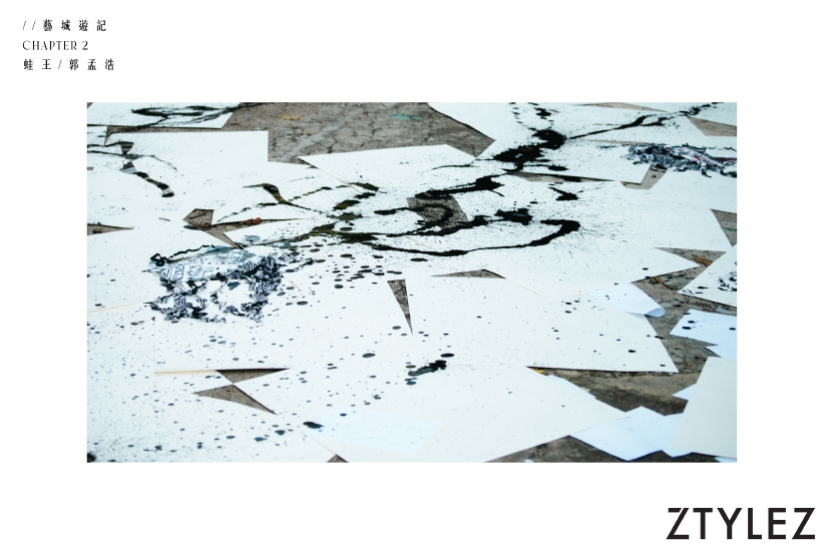
As we were still pondering what he could play with, the Frog King had already thrown the paintings that had passed the film on the ground, which was one of his works displayed in a recent large exhibition. He ruthlessly sprinkled them on the sandy ground, then laid out several large sheets of paper on the ground, and then took several bottles of ink to splash on the paper, and then asked us to throw stacks of A4 paper into the sky together. The paper flying in the sky returned to the ink-stained ground, with ink spreading on the surface. The Frog King took out a hose and sprayed water into the sky, causing the ink on the ground to blur, covering the originally pure white paper with ink. Finally, he took out a blowtorch and burned everything into ashes.
During the process of lightning speed, he repeatedly broke our imagination of creation with a series of impactful actions. Later, he explained that paper is an important carrier of creativity for modern people. When we throw these papers into the sky, it allows creativity to freely soar in the sky. Finally, the papers float down, soaked in ink, just like his long-standing creative practice, no matter how indulgent and rebellious, ultimately returning to ink. In this seemingly destructive series of actions, he is silently reshaping his conception of ink. Only by casting off constraints and wearing out these ready-made materials can we break existing boundaries and achieve true creative freedom.
Actually, this is not Frog King’s first time performing this, but for him, this experimental art emphasizes the spontaneity. Even though the concept is the same, each experiment will be different due to factors such as manpower, environment, materials, etc. What is being tested behind it all is flexible thinking and ideas. In the end, there is a mess left on the ground, which will take time to clean up. However, this highly consumptive performance, like his creative practice over the years, simplifies the complex, choosing the difficult over the easy. In his eyes, this refined performance done through thoughtful consideration is the true art he pursues. Even if not every viewer can understand something from his performance, at least he reaffirms his own ideas in each process – to create his ideal work, even if it means being in the minority.
“The value of creation cannot be measured solely by money.”
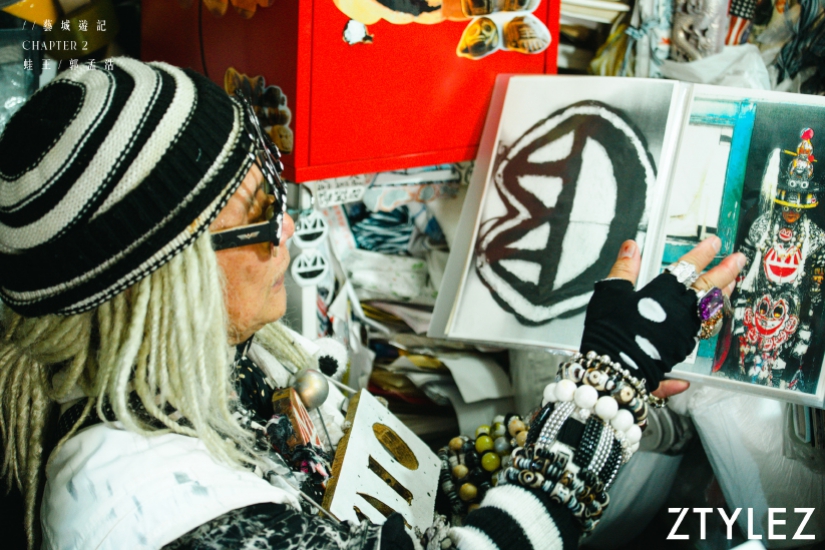
The Frog King has a naturally rebellious personality, with his own way of doing things in learning, creating, and living, not conforming to societal norms. If we were to say who inspired him in art, we must mention the ink master Lu Shoukun. The Frog King himself has long regarded him as a father figure. During his student days, when the teacher taught the students to paint with ink, the Frog King already thought of using live fish to dip in ink, placing them on paper to create “traces of struggle coming from their movements,” which resulted in a severe scolding from the teacher. Later, when Lu Shoukun passed away, he also felt that his art was not valued in Hong Kong, so he gave up his teaching position there and went to New York to develop his career. He stayed in the United States for fifteen years, occasionally watching the videotapes of his teacher’s past classes, saying, “Every time I think of him being gone, I can’t help but cry. Later, revisiting every word of his teachings in New York, I always felt that he gave me a lot of nourishment.” Lu Shoukun’s teachings inspired him to continue using ink in his creations, and this ink master not only provided him with enlightenment in ink, but also instilled in him a relentless pursuit of artistry and a unique style.
Creation is good, not creating is also good. Creation has always been a very contradictory process.
The Frog King has taken a different path on the ink road, facing years of doubt, but his perseverance and resilience have finally allowed him to stand firm on the contemporary ink road, becoming an irreplaceable force in the art world.
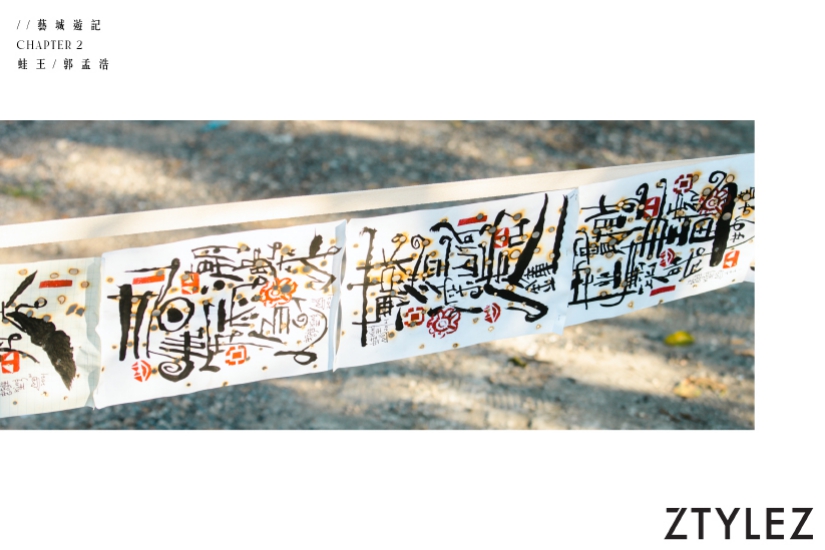
And today, the works that were once rejected by people have value in the art market. Frog King has participated in thousands of international art projects, creating continuously every day. His presence can be seen at major art fairs, the reopening of the Hong Kong Museum of Art, and the opening of the M+ Visual Arts Museum. However, Frog King, who loves creating and having fun, has not become arrogant because of his current status. On the contrary, he still often goes to communities and neighborhoods to play with residents, and even casually gives away his ink treasures and artworks to participants. In the past six months, he has launched a “Friend of Kwuntong Street” project in Yuen Long, inviting neighbors to wear frog glasses together, giving each of them a unique title written in Frog King’s special “calligraphy,” and having fun together, being affectionately called “Chairman” by the neighbors.
However, distributing works randomly is like singing against galleries and auction houses. We ask, isn’t this making your artistic path more difficult? He calmly says, “In theory, rarity makes things valuable. Selling works at a high price is indeed a commercial act, but the higher realm is not about these. If you find inspiration with substance and philosophical depth in a work, then the value of creation cannot be measured solely in terms of money.” Compared to decades ago when the public strongly rejected his work, enduring over 50 years to receive understanding and support from others is already extremely precious. Going against the tide in the art world for many years, it has been both painful and joyful, incomparable to any material possessions or fame.
“I am a worker of intangible cultural heritage with responsibilities, not just an artist.”
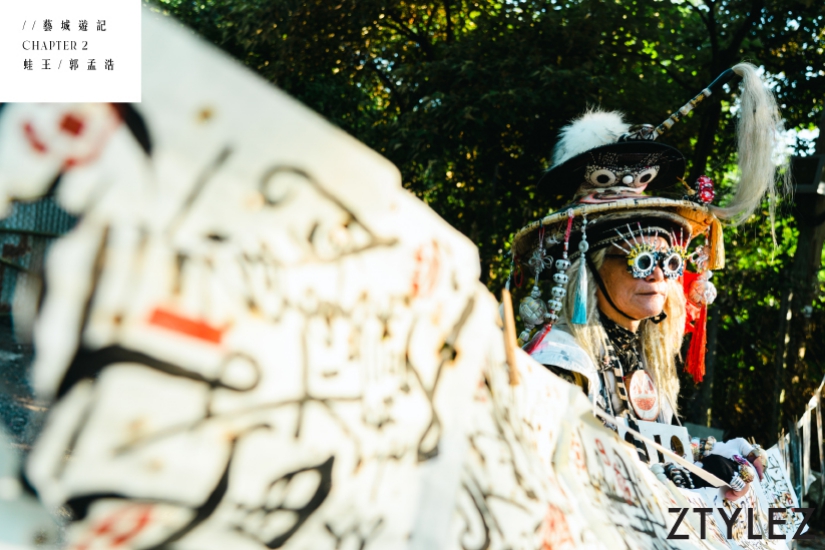
As the first person in Hong Kong performing arts, the appearance of the Frog King has indeed unprecedentedly created the ecology of conceptual art. However, how does he view his own influence in the art world? He said, “In fact, so many wonderful things have happened throughout history, they just haven’t been recorded. My creations are actually quite superficial.” As for his own artistic expression, he self-deprecatingly said, “I am the most old-fashioned and stupid one, covered in stuff, sweating profusely while working. It’s actually a foolish approach. But looking back, it has become the most outstanding one, because I have emerged from the primitive. In Hong Kong, everyone lives a normal life, suddenly a crazy person emerges, but in terms of art, it is the most unique.”
He once jokingly referred to himself as the “artist of the next century.” Decades ago, his creations are only now beginning to be accepted. Perhaps this pioneer of art harbors an unspeakable loneliness deep in his heart.
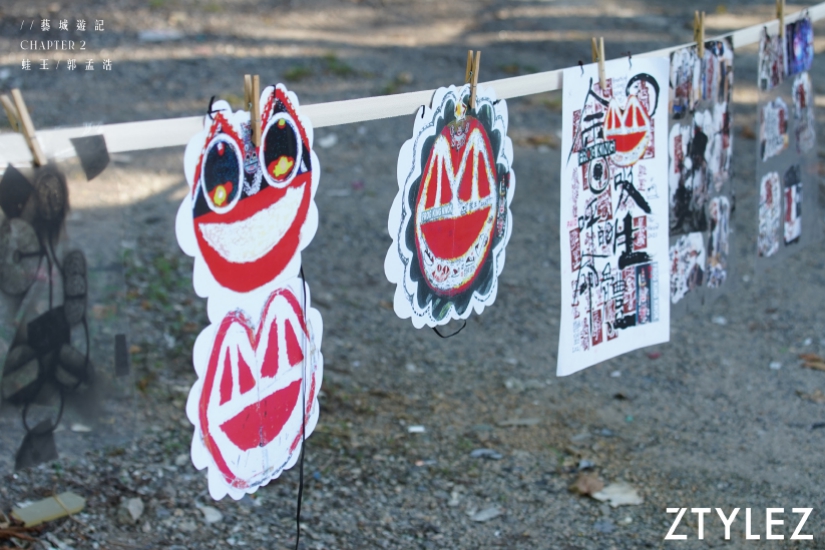
When he first made a name for himself in New York, he was even invited back to China to hold an exhibition. Since returning in 1995, the Frog King has never left. His contribution to the local art scene is undeniable, but compared to New York, which was seen as an art metropolis at the time, Hong Kong can be likened to swimming from a big pond to a small fish tank. What exactly can this place in Hong Kong bring to him that makes him willing to stay?
He said, “I received cultural education from the previous generation in Hong Kong, which inspired me a lot. My current creation is about interacting with people in society, which is actually a way of giving back to society. I believe that by continuing to work slowly, I can pass on my art and culture in society, like planting a fruit tree that will bear fruit someday in the future. In fact, the talents of the new generation also come from this process.” For a long time, Frog King’s creations have brought countless joy to everyone, and the reason he continues to create is to fulfill a sense of mission in cultural heritage. He believes that what he is doing now is a kind of “intangible cultural heritage,” and he is one of the inheritors.
“Frogtopia is a happy, joyful, ideal future world”

He shared with us, “Being an artist is really not easy to play with. Only after going through the toughest times can a work come out with depth and lasting appeal.” Over the past 50 years, the Frog King has done thousands of projects, putting his all into each one. He said, “As long as you treat it as a daily routine, you won’t feel the hardship.” Being able to achieve something, even just attracting a little attention from others, makes him happy.
At over eighty years old, the Frog King is no longer “hopping around” like he did when he was young. Holding a cane, he walks slowly but still carries a camera, frog glasses, and ink with him as he enters the community to play with his neighbors, inviting them into his created “Frogtopia,” a happy, joyful, and ideal future world. When tired from playing, he returns to the Frog Forest to rest and continue creating.
In the end, when we asked him what kind of artist he wanted to become, he replied without hesitation: “A happy frog, being happy is enough.” He once joked that he was still aiming for 9 million pieces of work. After finishing a day of shooting, we accompanied him from the new studio back to his home in Ping Shan. A month later, this corner of Frog Forest may be unrecognizable, but we know he has endless creativity. His dedication to art leaves the “Frog King Spirit” imprinted on every piece of land he has stepped on.
Frogtopia relocated, the focus has never been on the place itself, but on the artist’s instinct to create happiness. The “Frog Utopia” he spent his whole life building has never disappeared, just like his art, it has already taken root in the soil of Hong Kong, planting eternity.
Executive Producer: Angus Mok
Producer: Vicky Wai
Editor: Ruby Yiu
Videography: Anson Chan, Andy Lee
Photography: Anson Chan
Video Editor: Anson Chan, Andy Lee
Designer: Tanna Cheng
Special Thanks: Frog King Kwok

